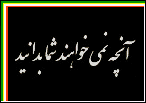به نام خداوند جان و خرد
کزین اندیشه برتر برنگذرد
A Study about the Persian Cultural Legacy and Background of the Sufi Mystics Shams Tabrizi and Jalal al-Din Rumi
By Rahgozari Minutalab
October 2009, Open Source. The author is not association with any modification of the current article but any author is free to use the materials within this article.
Note PDF version is recommended here:
http://www.azargoshnasp.com/Pasokhbehanirani/PersianPoetRumi.pdf
http://www.azargoshnasp.net/Pasokhbehanirani/PersianPoetRumi.pdf
Text version
http://azargoshnasp.net/Pasokhbehanirani/PersianPoetRumi.htm
منگر به هر گدایی که تو خاص از آن مایی
مفروش خویش ارزان که تو بس گران بهایی
به عصا شکاف دریا که تو موسی زمانی
بدران قبای مه را که ز نور مصطفایی
بشکن سبوی خوبان که تو یوسف جمالی
چو مسیح دم روان کن که تو نیز از آن هوایی
به صف اندرآی تنها که سفندیار وقتی
در خیبر است برکن که علی مرتضایی
بستان ز دیو خاتم که تویی به جان سلیمان
بشکن سپاه اختر که تو آفتاب رایی
چو خلیل رو در آتش که تو خالصی و دلخوش
چو خضر خور آب حیوان که تو جوهر بقایی
بسکل ز بیاصولان مشنو فریب غولان
که تو از شریف اصلی که تو از بلند جایی
تو به روح بیزوالی ز درونه باجمالی
تو از آن ذوالجلالی تو ز پرتو خدایی
تو هنوز ناپدیدی ز جمال خود چه دیدی
سحری چو آفتابی ز درون خود برآیی
تو چنین نهان دریغی که مهی به زیر میغی
بدران تو میغ تن را که مهی و خوش لقایی
چو تو لعل کان ندارد چو تو جان جهان ندارد
که جهان کاهش است این و تو جان جان فزایی
تو چو تیغ ذوالفقاری تن تو غلاف چوبین
اگر این غلاف بشکست تو شکسته دل چرایی
تو چو باز پای بسته تن تو چو کنده بر پا
تو به چنگ خویش باید که گره ز پا گشایی
چه خوش است زر خالص چو به آتش اندرآید
چو کند درون آتش هنر و گهرنمایی
مگریز ای برادر تو ز شعلههای آذر
ز برای امتحان را چه شود اگر درآیی
به خدا تو را نسوزد رخ تو چو زر فروزد
که خلیل زادهای تو ز قدیم آشنایی
تو ز خاک سر برآور که درخت سربلندی
تو بپر به قاف قربت که شریفتر همایی
ز غلاف خود برون آ که تو تیغ آبداری
ز کمین کان برون آ که تو نقد بس روایی
شکری شکرفشان کن که تو قند نوشقندی
بنواز نای دولت که عظیم خوش نوایی (دیوان شمس)
TABLE OF CONTENT
Introduction and reason for this article. 4
On the Persianized Seljuqs. 11
Some distortions due to nationalistic reasons. 15
Shams Tabrizi and his background. 25
Tabriz in the pre-Mongol and Ilkhanid era. 25
The Tabrizi Iranian language as a special case. 30
Example of Shams Tabrizi speaking the North West Iranic dialect of Tabriz. 38
On the importance of Safinaye Tabriz. 39
On the name of Tabriz and its districts. 42
Shams Tabrizi’s work Maqalaat 44
Shams Tabrizi of Ismaili origin? Conclusion. 45
Hesam al-Din Chelebi and other Rumi companions. 46
Baha al-Din Walad and Rumi’s parents. 50
Genealogy of Rumi’s parents. 50
On Vakhsh and Balkh and the languages of these areas. 54
Contribution to Persian culture and Baha al-Din Walad’s native language. 59
Conclusion on Baha al-Din Walad. 62
Rumi 63
The Persian lectures, letters and sermons of Rumi and his everyday language. 64
Response to couple of nationalistic statements with regards to Rumi’s prose and Rumi’s everyday language (not just literary language) 66
Rumi’s Persian poetry. 69
Response to an invalid arguments with regards to the Diwan. 73
Invalid Argument: “Rumi was a Turk because he has some verses in Turkish”. 73
Invalid Argument: Rumi uses some Turkish words in his poetry. 76
Invalid argument: Rumi has traces of Central Asia Turkish in his poetry. 77
Invalid argument: Rumi’s usage of the word Turk shows he was a Turk. 79
Persian poetry images and symbols: Turk, Hindu, Rum, Zang/Habash. 83
Which Turks are described in Persian Poetry?. 144
Views on ethnicity in the Mathnawi 150
Ethnicity in Aflaki 152
Sultan Walad, Rumi’s son. 165
Sultan Walad’s work. 165
Sultan Walad’s admits he does not know Turkish and Greek well 166
Sultan Valad’s view on the Turks. 169
Conclusion about Sultan Walad. 177
The Origin of Sama and a response to a false claim.. 178
On Rumi’s cultural predecessor and The Mawlawiya’s Spiritual lineage. 185
Conclusion of this article. 192
Bibliography. 203
Appendix A: Nick Nicholas: Greek Verses of Rumi & Sultan Walad. 208
Read the rest of this entry »
